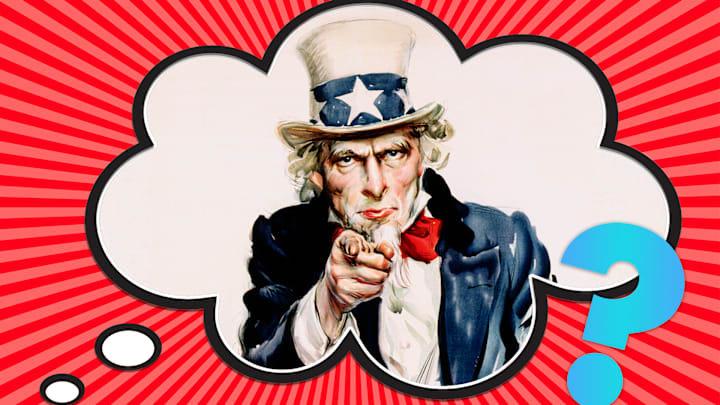Uncle Sam—clad in red, white, and blue and rocking a goatee and top hat—has represented the United States government for more than a century. But who is this stern, finger-pointing man, and how did he become such a popular American symbol?
Was Uncle Sam a real person?
Uncle Sam was based on a real person—at least, according to the government-sanctioned version of the symbol’s history. His name was Sam Wilson (yes, like The Falcon, Captain America’s successor in the Marvel Cinematic Universe). He was reportedly a pleasant man, well-liked in his hometown of Troy, New York.
But Wilson was far from a political figure. He was a meatpacker responsible for delivering food to soldiers during the War of 1812. According to legend, the nickname “Uncle Sam” was initially a mistake. The tale goes that Wilson always labeled the military’s meat as U.S. for “United States.” But the soldiers, knowing the meatpacker’s name, thought he was actually labeling them U.S. for “Uncle Sam.”
The above anecdote is certainly quaint, though it isn’t entirely accurate. References to Uncle Sam popped up in a handful of materials before Wilson began supplying meat to the U.S. troops.
However, the U.S. government still stands by the Wilson version of events: In 1961, Congress dubbed it the official account of Uncle Sam’s origin story.
The Origins of the Uncle Sam “I Want You” Poster
The symbol of Uncle Sam has been around since the 19th century. Thomas Nast—the political cartoonist who gave us the modern version of Santa Claus and popularized the elephant and donkey as political mascots—boosted the character’s image with his illustrations in the 1860s and ‘70s. But most people associate Uncle Sam with a later period thanks to an iconic 20th-century poster.
That now-famous image was originally created by artist James Montgomery Flagg in 1916. Flagg used concepts from earlier illustrations—Nast is credited with giving the character the facial hair and top hat he’s commonly depicted with—but the artist used his own likeness as inspiration. His version of Uncle Sam ran on the cover of the July 6, 1916, issue of the newspaper Leslie’s Weekly above the words “What Are You Doing for Preparedness?”.
That same image was later used as part of a recruitment campaign for the U.S. Army during World War I. Those posters, which showed Uncle Sam pointing at the viewer accompanied by the straightforward tagline of “I want you for U.S. Army,” cemented the symbol’s place in U.S. history. More than 4 million copies of the poster were printed; the military deployed the image again during World War II.
According to the Library of Congress, Uncle Sam wasn’t always trying to recruit soldiers, either. In the years between the world wars, he also reminded people to participate in the 1940 census and to remember daylight saving time, and various movements and groups have adopted his likeness to spread their own messages.
Read More About U.S. History:
Have you got a Big Question you'd like us to answer? If so, let us know by emailing us at bigquestions@mentalfloss.com.
